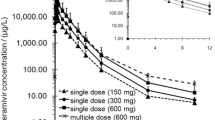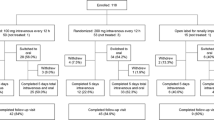Abstract
Objective
The prodrug oseltamivir has been shown to be efficacious and safe for the treatment of influenza for patients 1 year of age or older; however, pharmacokinetic information was lacking for children below 5 years of age. This study was conducted to assess the metabolic and excretory capacity of oseltamivir and its active carboxylate metabolite in young children.
Methods
Twelve healthy children aged 1–5 years received a single oral suspension dose of oseltamivir (45 mg for 3–5 years, 30 mg for 1–2 years). Plasma and urine concentrations of oseltamivir and the carboxylate were determined by means of liquid chromatography/tandem mass spectrometry.
Results
Mean peak plasma concentration and area under the plasma concentration–time curve values normalized to milligram per kilogram oseltamivir dose in the 1- to 2-year group are lower than those in the 3- to 5-year group. Mean body weight normalized oral clearance of oseltamivir and its carboxylate in younger subjects aged 1–2 years (259 ml/min/kg and 12.2 ml/min/kg) were, respectively, 52% and 30% higher than those in older subjects aged 3–5 years (170 ml/min/kg and 9.4 ml/min/kg).
Conclusion
The results demonstrate that infants as young as 1 year old can metabolize and excrete oseltamivir efficiently. The data derived from this study provide the starting dose of oseltamivir for further investigation in an efficacy study among influenza-infected infants less than 1 year of age.


Similar content being viewed by others
References
Simonsen L, Fukuda J (2000) The impact of influenza epidemics on hospitalizations. J Inf Dis 181:831–837
Neuzil KM, Mellen BG, Wright PF, Mitchel EF, Griffin MR (2000) The effect of influenza on hospitalizations, outpatient visits, and courses of antibiotics in children. N Engl J Med 342:225–231
Izurieta HS, Thompson WW, Kramarz P, Shay DK, Davis RL, Destefano F, et al (2000) Influenza and the rates of hospitalization for respiratory disease among infants and young children. N Engl J Med 342:232–238
Treanor JJ, Hayden FG, Vrooman PS, Barbarash R, Bettis R, Riff D, et al (2000) Efficacy and safety of the oral neuraminidase inhibitor oseltamivir in treating acute influenza. JAMA 283:1016–1024
Whitley RJ, Hayden EG, Reisinger KS, Young N, Dutkowski R, Ipe D, et al (2001) Oral oseltamivir treatment of influenza in children. Pediatr Infect Dis J 20:127–133
Oo C, Barrett J, Hill G, Mann J, Dorr A, Dutkowski R, et al (2001) Clinical pharmacokinetics and dose recommendation of oseltamivir suspension for the treatment of influenza in children. Paediatr Drugs 3:229–236
Wiltshire H, Wiltshire B, Citron A, Clarke T, Serpe C, Gray D, et al (2000) Development of a high-performance liquid chromatographic-mass spectrometric assay for the specific and sensitive quantification of Ro 64–0802, an anti-influenza drug, and its pro-drug, oseltamivir, in human and animal plasma and urine. J Chromatogr 745:373–388
He G, Massarella J, Ward P (1999) Clinical pharmacokinetics of the prodrug oseltamivir and its active metabolite Ro 64–0802. Clin Pharmacokinet 37:471–484
Conroy S, McIntyre J, Choonara I, Stephenson T (2000) Drug trials in children: problems and the way forward. Br J Clin Pharmacol 49:93–97
Milsap R, Szefler S (1986) Special pharmacokinetic considerations in children. In: Evans WE, Schentag JJ, Jusko WJ (eds) Applied pharmacokinetics, 2nd edn. Applied therapeutics. Vancouver, WA
Arant BS (1978) Development patterns of renal functional maturation compared in human neonate. J Pediatr 92:705–712
Yamakawa T, Itoh S, Onishi S, Isobe K, Hosoe A, Nishimura Y (1984) Development changes in hepatic esterase activity towards chloramphenicol succinate and its Michaelis-Menten constant of liver, kidney, and lung in human. Dev Pharmacol Ther 7:205–212
Stewart CF, Hampton EM (1999) Effect of maturation on drug disposition in pediatric patients. Clin Pharm 6:548–564
Acknowledgement
The study was fully sponsored by F. Hoffmann-La Roche Ltd., Basel, Switzerland.
Author information
Authors and Affiliations
Corresponding author
Rights and permissions
About this article
Cite this article
Oo, C., Hill, G., Dorr, A. et al. Pharmacokinetics of anti-influenza prodrug oseltamivir in children aged 1–5 years. Eur J Clin Pharmacol 59, 411–415 (2003). https://doi.org/10.1007/s00228-003-0639-6
Received:
Accepted:
Published:
Issue Date:
DOI: https://doi.org/10.1007/s00228-003-0639-6




